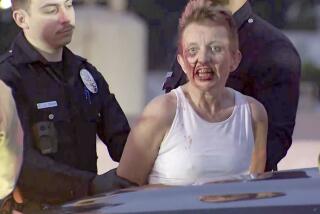The Roadblocks of Racing to Emergencies
According to ancient Greek myth, the music of sirens caused sailors to go mad with desire and wreck their ships on rocky shores.
In the modern American version of the tale, the wail of sirens emanates from emergency vehicles, not creatures that are half-woman, half-bird. But the results can be just as chaotic--especially for the emergency personnel rushing to the scene of an accident, fire or crime.
Anxious motorists freeze up and block traffic. Curious pedestrians step into the road. And particularly brazen drivers sometimes end up crashing into other vehicles--including the very ambulances, fire engines and squad cars answering the call for help.
“It’s extremely stressful because you have to have 110% of your focus and attention on everything around you, and an accident can happen in a split second,” said Los Angeles City Fire Capt. Jack Fry. “It’s very draining mentally and physically to drive ‘emergency.’ ”
As head of the paramedics bureau for southern Los Angeles, Fry zooms out every day to numerous incidents, his siren blaring, his lights whirling. He has notched his share of roadway headaches, even an accident or two caused by inattentive motorists. Such as the time he was hit by a “gutter runner”--someone trying to slip by the emergency crew by hugging the curb.
“Driving one of these emergency (vehicles) for 14 years,” he said, “it’s bound to happen.”
*
In a perfect world, drivers pull over to the right when an emergency vehicle approaches, clearing a path down the middle, as spelled out in California Vehicle Code Section 21806.
But the real world is not perfect.
“People will try and race us,” said paramedic Ruthie Rush of Station 46, which sits at Hoover Street and Vernon Avenue in South-Central Los Angeles. “Or someone will be standing on the side of the street, and all of a sudden they’ll dash out in the street like they’re playing chicken with us.”
Often motorists, their stereos booming, do not even hear the sirens. Others react like a deer in headlights, coming to a dead stop in the middle of the road and casting uncomprehending glances at impatient ambulance crews as if they are from a different country, said Rush’s partner, Dave French. “They’re just ignorant rather than deliberately doing something wrong.”
The biggest hazard is cross-traffic. The great majority of the roughly 150 accidents involving emergency vehicles each year in Los Angeles occur at intersections, city fire officials say.
Firetruck and ambulance drivers are instructed to stop at all red lights and stop signs, even though legally they are exempt from most traffic regulations when going “Code 3” (emergency mode). Rescue workers are also told not to exceed the posted speed limit by more than 15 m.p.h.
A recent ride with Fry in his Ford Crown Victoria proved the wisdom of these rules.
“Incident 784,” crackled the scanner about 9:30 one night. “Shooting in progress.” A 20-year-old man was reported wounded in the 1600 block of West 59th Street.
In a flash, Fry was out of the garage of Station 46, going Code 3 south on Hoover. At Slauson Avenue, he stopped: Even with his sirens and lights on--made more noticeable by the evening darkness--cross-traffic continued to hurtle through the intersection.
Along Slauson, motorists for the most part yielded the right of way, but some braked in the middle of the street. Fry and the shrieking ambulance barely missed a beat but had to slow down slightly as they looped around the mess.
“When one car does wrong, the others follow suit,” Fry sighed.
Still, he and the paramedic team were able to arrive at the scene--a two-mile drive from the station--within five minutes.
That is close to the average response time departmentwide, which is 5.8 minutes to a fire or medical emergency. And in the business of saving homes or lives, “seconds do matter,” Fry said.
Because of that, paramedics familiarize themselves with back routes and less-traveled roads to maximize their time. Rush and French of Station 46 know the secrets: Broadway is a good north-south alternative. Ditto Avalon Boulevard. And, of course, avoid the Harbor Freeway and Figueroa Street during rush hour.
The Harbor can be especially vexing because of major construction under way and the closure of several on- and off-ramps. Rush and French tried it anyway one day but quickly exited to escape the gridlock. They promptly found themselves in a long queue of cars on the off-ramp.
The clock was ticking. So, French said with a grin, he simply steered the ambulance down the dirt embankment and barreled right through a construction area. “Hang on!” he shouted. “We’re going four-wheel drive!”
It was not something he learned from the two-inch-thick black binder at the station labeled “Driver’s Training Manual.” Navigating an embankment also is not part of the obstacle course, or driving “rodeo” (which paramedics pronounce roh-DAY-oh), that ambulance and fire engine drivers negotiate once a year for practice and evaluation.
But when someone needs help, French has to find a way to get there. As long as it is fairly safe.
“If I’m going to cause an accident, then I’m not going to do that person any good,” he said. “But we’ve gone up on sidewalks if that’s the only way.”
More to Read
Sign up for Essential California
The most important California stories and recommendations in your inbox every morning.
You may occasionally receive promotional content from the Los Angeles Times.










